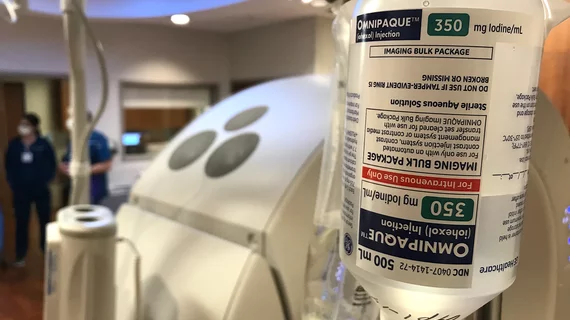Many CT techs unprepared to manage adverse contrast reactions
Though adverse events related to iodinated contrast are uncommon, CT technologists are responsible for responding to them. A new analysis gauges how prepared techs feel to do so.
Available data indicate that serious adverse reactions to low-osmolar intravenous contrast media (IVCM) agents occur in less than 1% of cases. However, some can be life-threatening, making the understanding of how to appropriately manage reactions a critical aspect of technologists’ responsibilities.
Research in BMC Medical Education suggests that many techs are well prepared to respond to adverse reactions, but there is ample room for improvement.
“The function of CT radiographers is crucial; they are frequently the first to identify indications of severe contrast media responses, requiring prompt and proficient interventions to minimize hazards to patient well-being,” noted Mustafa Mahmoud, with the department of radiological sciences at King Khalid University, and colleagues. “Although radiologists are primarily responsible for managing these reactions, international guidelines from the American College of Radiology, Royal College of Radiologists, European Society of Urogenital Radiology, and Royal Australian and New Zealand College of Radiologists also outline important responsibilities for CT radiographers.”
To get an idea of techs’ preparedness, researchers deployed a cross-sectional survey covering things like overall understanding of IVCM, factors that increase risk, patient readiness, detection of severe reactions and methods for reducing the likelihood of reactions. Individual factors, such as experience level, training and practice setting were considered alongside respondents’ answers.
The responses varied, but the overall average score of the group was 25.02 out of 40 total points. The majority reported having substantial knowledge of precautionary measures, but just 22% demonstrated a sufficient understanding of all five categories assessed.
Highlighting similar results from previous studies on the subject, the authors suggested gaps in knowledge could be due to “insufficient hands-on training and limited exposure to real-life emergencies.”
Not surprisingly, techs with more experience fared better overall on the assessment. However, the research team noted that techs working in departments without a standard set of rules addressing adverse reactions were less likely to exhibit a solid understanding of how to respond, regardless of their experience level.
“These findings suggest that experience alone is not sufficient—structured training and adherence to standardized policies play a critical role in building competence,” the group suggested.
Although the study focused on techs in Saudi Arabia, the authors noted that the issues uncovered in their work are not exclusive to the area, and that other studies from different regions have yielded similar results. This highlights the need for institutions to implement standardized protocols, in addition to mandatory training workshops annually to ensure techs are adequately prepared to respond to patients’ needs in the event of a reaction, the group advised.
Learn more about the results here.

